No-Till Farmer
Get full access NOW to the most comprehensive, powerful and easy-to-use online resource for no-tillage practices. Just one good idea will pay for your subscription hundreds of times over.

Since he started seeding radishes as cover crops 6 years ago, Illinois no-tiller Daniel Steidinger says higher yields and improved water infiltration are two major benefits he’s seen.
Onfarm corn plots, with and without radishes, show a 50-bushel yield difference, with the higher figure going to cover-cropped plots, Steidinger told attendees at the 2013 Conservation Technology Information Center (CTIC) Conservation In Action Tour.
Steidinger says the benefit of increased water infiltration was seen almost immediately after he seeded radishes, when a wet spring came along. He found no standing water on a flat farm that normally didn’t drain well, which he attributes to the radishes’ taproots that went down about 32 inches.
The soil-loosening abilities of radishes have also allowed Steidinger to expand no-till practices to 300 acres on his farm in Fairbury, Ill., where the cover crop has been seeded.
But finding the right management system for these brassicas can take some time. Steidinger admits it was a 3-year process to get the details worked out. Timing, pH levels and the presence of other cover crops can affect how radishes fit into a no-tiller’s cover-cropping system.
Timing Key. One of the first things a no-tiller should consider when seeding radishes is the seeding date.
Steidinger says timing was one of the initial challenges he faced. Producing corn, soybeans and wheat, he only seeds radishes with a seeder after his wheat crops because he found they didn’t develop as much as he preferred after corn and soybeans.
He attempts to…